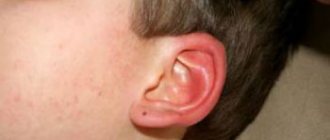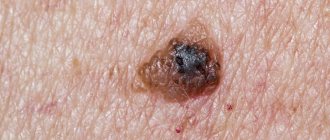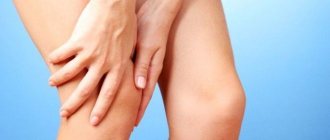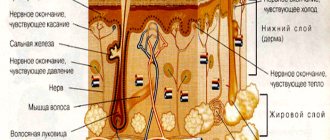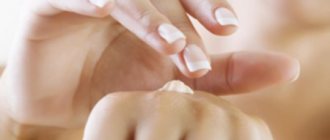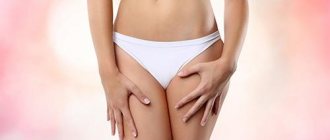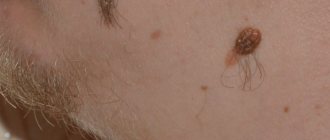Kinds
Hyperhidrosis of the head is a local type of hyperhidrosis, that is, it appears only in a certain area of the body. In most cases, increased sweating with craniofacial hyperhidrosis is observed only in the face, but sweating can also affect certain parts of the face (beads of sweat can appear only in the nose, cheeks, forehead or upper lip).
In some cases, excessive sweating occurs over the entire surface of the head and can even affect the neck.
Craniofacial hyperhidrosis can be:
- Primary (essential). It occurs regardless of any disease; a clear cause cannot be established. It was found that in 40% of cases, facial sweating was observed in the patient’s relatives, therefore, hypothetically, primary hyperhidrosis is of hereditary origin. It can appear at any age, but is usually observed from childhood.
- Secondary. Always develops under the influence of some disease.
- Constant, independent of weather and temperature.
- Seasonal, appearing only under certain weather conditions.
- Intermittent, in which periods of absence of increased sweating alternate with exacerbations.
Sweating can be expressed in varying degrees - from light perspiration, in which patients rarely consult a doctor, to profuse sweating, when sweat literally drips down the face.
In some cases, facial hyperhidrosis is combined with increased sweating of the palms and redness of the face.
As a rule, sweating disorders are symmetrical, but there are also unilateral forms.
How to deal with excessive sweating of the head in women
Craniofacial hyperhidrosis can provoke a change in the character of the sick person. People suffering from it become withdrawn and irritable.
Since there are many causes for hyperhidrosis of the head and face, there is no single therapeutic regimen. Each patient requires an individual approach. You need to start fighting by visiting a dermatologist. He must establish a cause-and-effect relationship and, if necessary, redirect the patient to another specialist.
If the pathology develops against the background of a dysfunction of the nervous system, you need to take sedatives (Valerian, Fitosed). They help reduce nervous excitability and normalize sleep.
People with excess body weight are recommended to adhere to a low-calorie diet and increase physical activity. It is important to completely give up flour and sweets, processed foods and fast food. The diet will normalize metabolic processes and this will help normalize sweating.
Timely treatment of infectious diseases and chronic pathologies reduces the likelihood of developing scalp hyperhidrosis. Women who are going through menopause can be prescribed therapy to help eliminate hot flashes and tides, allowing them to balance their hormonal levels.
Botox injections
Currently, cranial hyperhidrosis is successfully treated with Botox injections. Injecting this drug under the skin helps block the transmission of nerve impulses to the sweat glands transmitted by the hypothalamus, the part of the brain responsible for thermoregulation of the body. The effectiveness of the procedure is 99%. It lasts for six months, then Botox treatment is repeated.
Homeopathy
If Botox injections are contraindicated, then homeopathy is used. For each specific case, a separate diagram is drawn up. This should be done by an experienced doctor. For these purposes it is used:
- "Gepar Sulfur" - drops that are diluted with water and taken in courses. They are prescribed in the presence of loose fullness, and when sweat on the head appears with minor exertion.
- “Silicea” is a drug that is actively used to treat severe sweating of the head at night.
- “Pulsatilla” is an effective homeopathic remedy that is prescribed when scalp hyperhidrosis is accompanied by severe itching. Its use is indicated for women suffering from sweating during menopause.
- “Sambucus Nigra” is a complex that helps get rid of local sweating caused by bronchopulmonary pathologies.
Causes of primary facial hyperhidrosis
Sweating of the head very often occurs during stress and can be combined with erythrophobia (fear of blushing), provoked by the consumption of spicy, spicy and hot foods, hot drinks and alcohol.
The primary form of facial hyperhidrosis is caused by increased activity of the sympathetic nervous system (SNS). The sweat glands are the border nodes of the sympathetic chain, and the regulation of sweating in these glands occurs with the help of sympathetic unmyelinated postganglionic class C nerve fibers (cholinergic).
Stimulation of efferent cholinergic fibers occurs under the influence of acetylcholine (neurotransmitter) and cholinomimetics, and blocking occurs under the influence of anticholinergics. The immediate stimulus for sweating is the entry of extracellular calcium into secretory cells under the influence of aldosterone (an adrenal hormone). In stressful situations, the level of aldosterone in the blood increases, therefore, during stress, patients with increased SNS activity experience increased sweating.
Nutritional sweating is also associated with the activity of the sympathetic nervous system, since there are neuronal connections in the brain stem between the sympathetic pathways and the salivary nuclei.
The intensity of sweating is also influenced by hereditary factors - it has been established that it is inherited in an autosomal dominant manner with incomplete penetrance (it appears only in some offspring).
Primary hyperhidrosis is characterized by increased sweating during the day and normal sweating during sleep (adequate reactions to changes in ambient temperature at night are maintained).
How to get rid of hyperhidrosis, or excessive sweating of the face
How unpleasant it is when makeup, on which you spent a lot of time, disappears and literally floats on your face, like a snowman on a hot spring day. The culprit of this condition is hyperhidrosis, or, more simply, excessive sweating. What are the causes of the disease, and how to get rid of such an unpleasant condition, this article will tell you.
Causes
Sweat is simply necessary for a person to regulate body temperature, as well as remove toxins and harmful substances from the body. Usually, its droplets begin to appear due to excessive physical activity and due to high body or environmental temperature. However, in some people, sweating may appear out of the blue due to a disease called hyperhidrosis.
There are primary and secondary hyperhidrosis. Primary causes include heredity, as well as a malfunction in the nervous system. This type of hyperhidrosis is difficult to treat.
The list of reasons for the secondary type is much wider, it includes:
- diseases of the hormonal system, namely pathologies of the thyroid gland, diabetes mellitus;
- hormonal imbalances during menopause and pregnancy;
- taking certain medications;
- alcoholism;
- unbalanced diet, abuse of foods high in food additives;
- excess weight;
- diseases of the cardiovascular system;
- increased skin sensitivity to cosmetics;
- nervous and emotional stress.
Often, excessive sweating is a symptom of certain diseases: HIV infection, Parkinson's disease, oncology, tuberculosis, stroke, malaria and others.
Therefore, hyperhidrosis can be both a signal of a serious illness and a sign of an unhealthy lifestyle.
If sweating occurs at night, this may be a symptom of tuberculosis; swollen lymph nodes, fever and cough indicate an infectious disease. Your doctor will help you determine the exact cause of the illness.
Causes of secondary hyperhidrosis
Hyperhidrosis of the head can be a consequence of hormonal changes in the body during puberty, menopause, or disturbances in the functioning of the endocrine system.
Secondary facial hyperhidrosis can be caused by:
- Red granularity of the nose is a dermatosis that is hereditary in nature and appears most often in physically weakened children. By the time of puberty, in most cases the disease regresses on its own, but sometimes it can persist for an indefinite period. It manifests itself as rosacea-like bluish redness and severe sweating of the nose (looks like dew drops), a rash of small papules of light pink or dark red color. Changes may affect the chin, cheeks and upper lip.
- Lucy Frey's auriculotemporal syndrome (gustatory sweating), in which intense sweating, redness of the skin and paroxysmal pain in the ear, temporal and mandibular region are observed when eating food (especially hot or spicy), intense physical activity or stress. The pathology affects the parotid-temporal part, as it is a consequence of damage to the auriculotemporal nerve due to mumps or facial trauma, including complications of surgery.
- Cord tympani syndrome, which is characterized by increased sweating in the chin area due to taste irritation. It develops as a consequence of surgical trauma with cross-excitation of sympathetic fibers, which are located next to a pair of sympathetic fibers of the submandibular gland.
- Blue spongy nevus is a type of hemangioma that is usually localized on the trunk and upper extremities and is accompanied by night pain and regional sweating.
- Erythromelalgia is a paroxysmal dilatation of the small arteries of the legs, arms, and in some cases of the face, which occurs for an idiopathic (unidentified) reason or as a symptom of frostbite or other diseases. It manifests itself as redness, pain, swelling and increased temperature of the skin of the affected areas, as well as increased sweating.
- Syringomyelia (a chronic progressive disease of the nervous system with the formation of cavities in the spinal cord), capsular hemiplegia (a conduction disorder of the central neuron of the pyramidal tract) and lesions of the cerebral cortex. These pathologies are characterized by the development of contralateral hyperhidrosis, which affects only one side of the face.
With syringomyelia, segmental sweating disorders develop slowly and can affect both one side of the face and both parts.
Iatrogenic facial hyperhidrosis also occurs (associated with side effects of antiemetics, aspirin, insulin, analgesics and a number of other medications).
Methods for treating hyperhidrosis
Treatment of scalp hyperhidrosis is a rather lengthy process. There are several ways to cure sweating of the head: the first is to use conservative treatment, the second is surgical.
Of course, first of all it is worth discovering the cause and starting to eliminate it. In order to alleviate the situation and get rid of the disease, all kinds of treatment methods and remedies are used: antiperspirants, medications, physiotherapy. Recently, folk remedies have become increasingly popular; they are highly effective, affordable and contain only natural ingredients.
Among the most common methods is the use of strongly brewed sage. A glass of decoction should be drunk throughout the day. The remedy is especially useful for women whose disease is associated with menopause or hormonal disorders.
No less effective are lotions made from St. John's wort and oak bark. The ingredients must be poured with boiling water and left for an hour. The resulting decoction should be divided into three doses and washed with it throughout the day (you can also rinse your scalp and hair).
When these kinds of methods do not help, it is worth using other methods and solving the problem radically.
You should start by consulting a specialist; only a doctor can prescribe the correct treatment. An excellent solution in the fight against the disease is to take sedatives.
If desired, the doctor will refer the patient for Botox injections. They block the nerves for a while, and the intensity of sweating is therefore significantly reduced. Important! The administration of the drug cures completely, but eliminates the problem for a while. After six months, the procedure will have to be repeated again.
As for the surgical method, if there is excessive sweating of the head, a sympathectomy is performed. During the operation, the doctor cuts the nerves responsible for the functioning of the sweat glands. Of course, manipulation will permanently relieve excessive sweating of the head, but there is a high probability of compensatory hyperhidrosis. In other words, sweating will appear in some other place, for example, the feet.
In the desire to get rid of an illness, it is important to choose the right method. To reduce symptoms, the patient should adhere to a diet: exclude spicy, salty, smoked, fried foods, and maintain a drinking regime. All personal hygiene products must be selected strictly taking into account your skin type and hair structure.
Medications
Treatment of hyperhidrosis of the head and face is carried out using medications. First of all, you need to carry out sedative therapy using sedatives: infusion of valerian, motherwort, Novo-passit.
Other drugs are selected taking into account the causes of excessive sweating.
- Nervous hyperhidrosis is treated with Belloid.
- In case of pathologies of the nervous system, the drug Bellaspon is indicated.
- If excessive sweating is associated with mental disorders, then therapy with Phenazepam is carried out.
- Manifestations of menopause are treated with hormonal drugs prescribed after analysis by a doctor.
Simple ways
Since then, when in the history of mankind there were occasional periods when there was no need to be afraid of dying of hunger, people noticed that with excess body weight a person begins to sweat much more intensely than usual . Simply put, if you are overweight, then fighting sweating will be pretty pointless if you don't get in shape first.
In addition to reducing the load on the heart, maintaining it allows you to normalize the functioning of your body's thermoregulation system, which will also help reduce the degree of sweating. Let us note that today cosmetologists and nutritionists are strongly against rapid weight loss, as well as heavy diets and daily feats in the gym. This approach may not only not help cope with excess weight, but also cause various health problems. Daily walks of at least half an hour to an hour, as well as (if possible) jogging will be enough. There is also no need to become like marathon runners: it is enough to run at least half a kilometer a day.
Proper nutrition
This is also an important factor that is often forgotten. Eating excessively fatty, smoked and salty foods not only aggravates the situation with sweating, but also leads to the fact that the sweat produced by the body acquires a very pungent and unpleasant odor. But the sweating itself is due to the fact that the body is forced to spend a lot of energy to digest “heavy” food. Metabolism accelerates and the activity of sweat glands increases.


